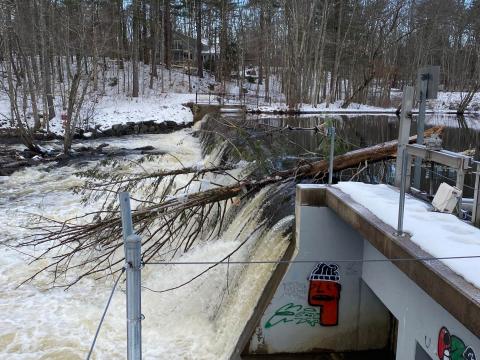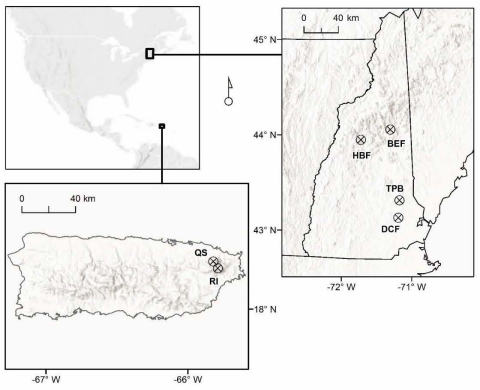This research was published in the INSPIRED: A Publication of the New Hampshire Agricultural Experiment Station (Spring 2024)
Researchers: H. M. Fazekas, W. H. McDowell, J. B. Shanley and A. S. Wymore
As more is learned about rivers’ role in affecting climate change, New England’s watersheds are being seen as having greater impact on maintaining and restoring ecological balance. Watershed ecosystems—pivotal for their biodiversity and ecological services—also perform the essential function of modulating nutrient transport to downstream water bodies. The extent to which New England watersheds help regulate the flow and concentration of nutrients—especially during extreme weather events—remains an open question, the answer to which could help better understand rivers’ roles in mitigating climate change.
Methodology
The study developed a detailed analysis of sensor data from six distinct watersheds—four in New Hampshire and two in Puerto Rico—over seven years (Fig. 1). These high-resolution data provided insights into how fluctuations in precipitation and temperature affect the relationship between nutrient concentration, including nitrate and dissolved organic matter, and water discharge—key indicators of the watershed’s ability to transport and transform nutrients.
By examining the concentration-discharge behavior in relation to weather anomalies, the study could deduce the underlying hydrological and biogeochemical processes that dictate nutrient mobility within these ecosystems. That is, the various chemical, physical, and biological processes that change the forms, structures, and bioavailability of nutrients.
Results and Impacts
Nutrient Transport and Transformation
In conditions wetter than typical, the results indicate that New England’s watersheds function akin to conveyor belts, transferring nutrients to other aquatic systems such as lakes and estuaries without significant transformation of those nutrients. Nutrients are delivered to downstream water bodies, where they can accumulate and impact water quality and the ecological integrity of these systems. This accumulation can cause issues like eutrophication—the buildup of nutrients such as nitrogen and phosphorus in water bodies leading to excessive plant and algal growth that depletes oxygen, harming aquatic life.
During drier and warmer periods, there was a stark increase in the variability of nutrient concentrations, suggesting the watersheds’ capacity to act as transformers. Under these weather conditions, nutrients are likely retained and processed within a watershed, potentially reducing the risk of eutrophication in downstream ecosystems.
Impact of Climatic Extremes
The findings indicate that as extreme weather becomes more common, predicting the effect on water quality, particularly nutrient loads, is increasingly challenging. This unpredictability is a concern for New England’s waterways, where nutrient concentrations are essential for the health of fisheries, food webs, and the region’s recreational appeal.
Land-use and Policy Implications
As research continues to show the influence of New England’s watersheds on helping the region adapt to increasing climate extremes, rethinking and adapting land-use management strategies and public policy to leverage critical natural resources will be key.
Additionally, the findings highlight the importance of policymakers considering how New England watersheds are impacted by and impact the transfer of nutrients across water bodies and landscapes. These dynamics affect ecosystems and the region’s economy, underscoring the need for forward-looking conservation and land-use policies.
This material is based on work supported by the NH Agricultural Experiment Station through joint funding from the USDA National Institute of Food and Agriculture (under McIntire-Stennis award number 1019522 and Hatch award number 1022291) and the state of New Hampshire. Additional funding came from the National Science Foundation and EPSCoR projects Canary in the Watershed (NSF EPS-1929148) andEcosystems and Society (NSF EPS-1101245), the Luquillo Critical ZoneObservatory (EAR-0722476, 1331841),and StreamPulse (EF-1442444).
Key Findings
- Extreme weather events, including droughts and heavy rainfall, can significantly alter nutrient loads in waterways, producing unpredictable effects on water quality.
- Heavy precipitation events result in watersheds acting as “conveyor belts” that transport material to streams.
- Conversely, drier conditions increase nutrient concentration variability, resulting in greater ecological and chemical interactions that modify nutrient content before it’s deposited downstream.
About the Co-author

Adam Wymore, Associate Professor of Natural Resources and the Environment
Contact information: Adam.Wymore@unh.edu, FindScholars profile


Fig. 1. Map of study sites in New Hampshire (HBF = Paradise Brook; BEF = Albany Brook; TPB = Trout Pond Brook; DCF = Dowst Cate Forest) and Puerto Rico (QS = Quebrada Sonodora and RI = Rio Icacos).

